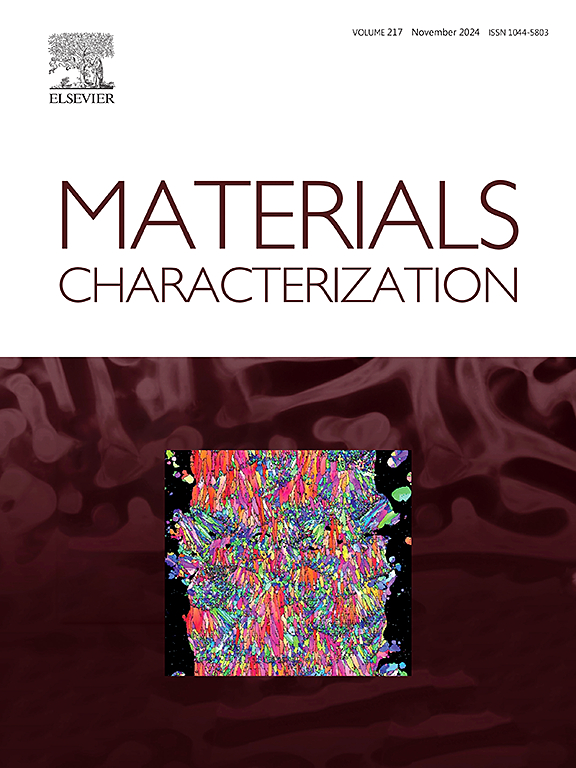Development of a novel deleterious phases analysis and detection method for stainless steel
IF 5.5
2区 材料科学
Q1 MATERIALS SCIENCE, CHARACTERIZATION & TESTING
引用次数: 0
Abstract
The integrity and performance of stainless steel can be significantly impacted by thermal aging, leading to the formation of deleterious phases such as sigma and chi phase. These deleterious phases, which are often enriched in chromium and molybdenum, affect the steel's mechanical properties by reducing ductility and toughness. Traditional methods for detecting and analysing these phases are either not consistent, costly, or lack the precision necessary for a comprehensive analysis.
This study introduces a novel Python based method for the qualitative and quantitative analysis of deleterious phases. This method is applied to thermally aged 316 L stainless steel, utilizing advanced image processing techniques, including Contrast Limited Adaptive Histogram Equalization (CLAHE) and automated particle detection algorithms, this method analyses Scanning Electron Microscopy (SEM) images to identify bright particles as an indication of phase changes. The methodology is capable of processing both individual images and batches of micrographs, providing detailed statistics on the number of particles, area percentages, average aspect ratio, circularity, particle density, spatial distribution metrics and additional particle statistics.
Results showed that the area percentage of deleterious phases increased with decreasing aging temperature and increasing time, ranging from 2 % to 13.43 %. The proposed method's reliability was validated against X-ray diffraction and ImageJ software demonstrating its accuracy and sensitivity. By offering precise, scalable, and user-friendly quantitative analyses, this methodology represents a valuable tool for industrial quality control, material optimization, and life prediction of stainless-steel components, particularly in critical energy applications.

一种新的不锈钢有害相分析检测方法的建立
热时效会严重影响不锈钢的完整性和性能,导致sigma相和chi相等有害相的形成。这些有害相通常富含铬和钼,通过降低延展性和韧性来影响钢的机械性能。检测和分析这些阶段的传统方法要么不一致,要么成本高昂,要么缺乏全面分析所需的精度。本研究介绍了一种新的基于Python的有害相定性和定量分析方法。该方法应用于热时效316l不锈钢,利用先进的图像处理技术,包括对比度有限自适应直方图均衡化(CLAHE)和自动颗粒检测算法,该方法分析扫描电子显微镜(SEM)图像,以识别明亮的颗粒作为相变的指示。该方法能够处理单个图像和批量显微照片,提供关于颗粒数量,面积百分比,平均纵横比,圆度,颗粒密度,空间分布度量和其他颗粒统计的详细统计数据。结果表明:随着时效温度的降低和时效时间的延长,有害相的面积百分比逐渐增大,为2% ~ 13.43%;通过x射线衍射和ImageJ软件验证了该方法的准确性和灵敏度。通过提供精确、可扩展和用户友好的定量分析,该方法代表了工业质量控制、材料优化和不锈钢组件寿命预测的宝贵工具,特别是在关键能源应用中。
本文章由计算机程序翻译,如有差异,请以英文原文为准。
求助全文
约1分钟内获得全文
求助全文
来源期刊

Materials Characterization
工程技术-材料科学:表征与测试
CiteScore
7.60
自引率
8.50%
发文量
746
审稿时长
36 days
期刊介绍:
Materials Characterization features original articles and state-of-the-art reviews on theoretical and practical aspects of the structure and behaviour of materials.
The Journal focuses on all characterization techniques, including all forms of microscopy (light, electron, acoustic, etc.,) and analysis (especially microanalysis and surface analytical techniques). Developments in both this wide range of techniques and their application to the quantification of the microstructure of materials are essential facets of the Journal.
The Journal provides the Materials Scientist/Engineer with up-to-date information on many types of materials with an underlying theme of explaining the behavior of materials using novel approaches. Materials covered by the journal include:
Metals & Alloys
Ceramics
Nanomaterials
Biomedical materials
Optical materials
Composites
Natural Materials.
 求助内容:
求助内容: 应助结果提醒方式:
应助结果提醒方式:


